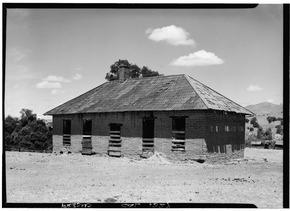Fort Miller, California facts for kids
Quick facts for kids
Fort Miller
|
|
|---|---|

Fort Miller Hospital, c. 1935
|
|
| Country | United States |
| State | California |
| County | Madera County |
| Fort Miller | 1852 |
| Elevation | 561 ft (171 m) |
| Reference #: | 584 |
Fort Miller, also called Camp Barbour, was an old fort in California. It was built on the south side of the San Joaquin River. Today, the land where the fort once stood is covered by Millerton Lake. This lake was created in 1944 when the Friant Dam was built. Fort Miller is an important historical site and is listed as California Historical Landmark #584.
Contents
History of Fort Miller
In early 1851, a temporary army camp was set up by the San Joaquin River. It was named Camp Barbour after George W. Barbour, who was a U.S. government official working with Native American tribes in California.
At Camp Barbour, U.S. officials met with many California tribes on April 29, 1851. They signed a treaty that created the Fresno River Reservation. This was a special area where the tribes would live. However, some tribes, like the Ahwahneechee and Chowchilla, did not agree to the treaty. They refused to move to the reservation. This disagreement led to a conflict known as the Mariposa War.
Building a Permanent Fort
As mining grew in the area and new reservations were formed, a stronger, permanent fort was needed. So, Camp Barbour was turned into a full fort. Lieutenant Tredwell Moore of the U. S. Army helped make it ready. The new fort was renamed Fort Miller in honor of Major Albert S. Miller.
Fort Miller was built on a wide part of the San Joaquin River. This location made it easy to reach local mining camps. The fort had several buildings, including a blockhouse, barracks for soldiers, officers' quarters, and a mess hall. A hospital was added in 1853. However, the area was known for its very hot summers.
Fort Miller After the War
By 1858, there was less conflict with local tribes. The army decided to leave Fort Miller. The soldiers moved out, but all the buildings were left standing. A local caretaker was hired to look after the fort.
During the American Civil War, which started in 1861, there were concerns about people in the nearby towns. Some reports said that locals were celebrating the Southern states' cause. In 1863, soldiers were sent back to Fort Miller to check on the situation. They found no major problems with people supporting the South.
The army left Fort Miller for good on December 1, 1864. In 1866, the buildings were sold off. The land and some remaining structures became a ranch owned by Judge Charles A. Hart. Later, William H. McKenzie bought the ranch.
The old fort buildings stood until 1944. They were taken down to make way for the Friant Dam and Millerton Lake. The blockhouse from Fort Miller was moved to Roeding Park in Fresno for a while. Later, it was moved again and given to the Table Mountain Rancheria tribe.
Fort Miller's Legacy
Fort Miller gave its name to a nearby town that grew up to its west. This town was first called Rootville, but its name was changed to Millerton. Millerton became the very first county seat for Fresno County. The town was later abandoned, but its name lives on with Lake Millerton.
A middle school in the Fresno Unified School District is named after Fort Miller. This shows how important the fort's history is to the area.
Fort Miller is recognized as a California Historical Landmark. It was added to this list as landmark #584 on May 22, 1957. It is also on the list of historic places for Fresno County. The Fort Miller blockhouse is considered the oldest building still standing in Fresno County. It is listed separately on the county and city of Fresno registers of historic places.



